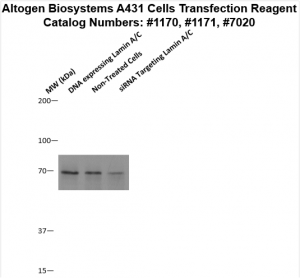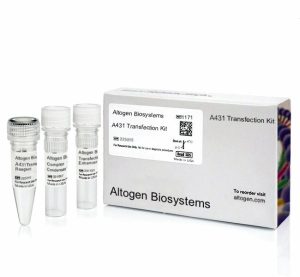Description
Purchase Orders: Click “Add to Cart” button to order, then email PO to orders@altogen.com.
Product Availability: In Stock.
Transfection Reagent for A431 Cells (Epidermoid Carcinoma Cells, CRL-1555)
-
Proprietary cationic lipids formulation
-
High transfection efficiency of small RNA (siRNA, shRNA, miRNA), mRNA, pDNA
-
Effective and robust intracellular delivery
-
Kit includes Transfection Enhancer reagent
-
Produces consistent results, lot-to-lot, plate-to-plate, and well-to-well
-
Work in the presence of serum
-
A proven reagent for establishing stable cell lines
-
Optimized transfection protocols are adapted for use with both standard & reverse transfection methods
-
Download in vitro A431 transfection protocol: [PDF]
- Download A431 CRISPR/Cas9 transfection protocol: [PDF]
- Download PowerPoint presentation for A431 cells transfection kit: [PPT]
- UPC/GTIN/EAN: 860002089713
-
Brand: ALTOGEN®, developed and manufactured by Altogen Biosystems
Transfection Efficiency:
Reagent exhibits at least 81% transfection efficiency of siRNA delivery. Transfection efficiency was determined by real-time RT-PCR.
Transfection Protocol and SDS:
Download Altogen Biosystems A431 Transfection Protocol: [PDF]
Download SDS: [PDF]
Product Description:
Optimized transfection kit for high transfection efficiency of A431 cell line, human epidermoid carcinoma cells commonly used in biomedical research. Compatible with DNA and RNA transfection.
A-431 Cell Line:
According to the American Cancer Society, epidermoid or squamous cell carcinoma is one of the most prevalent types of skin cancer that occurs in various parts of the body, with over 1 million cases being diagnosed annually. It can be triggered by UV exposure, and new therapies for advanced stages of the disease are desperately needed. There are over thirty cancer cell lines that are used in epidermoid and squamous cell carcinoma research including A-431. The A-431 cell line was established from the epidermis (skin) of an 85-year-old female patient who suffered from epidermoid carcinoma. These cells exhibit an epithelial morphology and are tumorigenic. A-431 was derived by D.J. Giard et al. from solid tumors, along with many other cell lines. This cell line could be useful for studying of medical treatments and for research of certain types of skin cancer. A431 is a human epidermoid carcinoma cell line that was originally derived from a skin biopsy of a patient with vulvar squamous cell carcinoma. This cell line is commonly used as a model system for studying skin cancer and for evaluating potential therapies. A431 cells are known for their high level of expression of the epidermal growth factor receptor (EGFR), which makes them useful for studying the signaling pathways that are activated by EGFR and for evaluating potential EGFR-targeted therapies. A431 cells are commonly cultured as adherent monolayers and have been shown to express markers of epidermal differentiation, such as keratins and involucrin. They are also known to be sensitive to certain chemotherapeutic agents and radiation therapy, which makes them useful for studying drug resistance mechanisms and testing novel therapeutic strategies. In addition to their use as a model system for studying skin cancer, A431 cells have been used to study a wide range of biological processes, including cell signaling, apoptosis, and autophagy. They have also been used to study the interactions between cancer cells and the immune system and to evaluate potential immunotherapies for skin cancer. Overall, the A431 cell line is a valuable tool for studying skin cancer and has contributed significantly to our understanding of the molecular mechanisms underlying this disease.
Mutations:
| TP53 | 7157 | 37 | 17 | 7577120 | 7577120 | Missense_Mutation | SNP | C | T |
| KHDRBS2 | 202559 | 37 | 6 | 62995783 | 62995783 | Missense_Mutation | SNP | G | A |
| LINGO2 | 158038 | 37 | 9 | 27949442 | 27949442 | Missense_Mutation | SNP | G | T |
| ZNF488 | 118738 | 37 | 10 | 48370999 | 48370999 | Missense_Mutation | SNP | G | A |
| PDE3A | 5139 | 37 | 12 | 20766419 | 20766419 | Missense_Mutation | SNP | G | A |
| DAAM1 | 23002 | 37 | 14 | 59834206 | 59834206 | Missense_Mutation | SNP | C | G |
| HK3 | 3101 | 37 | 5 | 176314737 | 176314737 | Missense_Mutation | SNP | C | T |
| OR5B2 | 390190 | 37 | 11 | 58189810 | 58189810 | Missense_Mutation | SNP | G | C |
| ZFC3H1 | 196441 | 37 | 12 | 72057069 | 72057069 | Missense_Mutation | SNP | C | G |
| CDAN1 | 146059 | 37 | 15 | 43017747 | 43017747 | Silent | SNP | C | T |
Data:

Figure 1. siRNAs targeting Lamin A/C mRNA or non-silencing control siRNA were transfected into A431 cells following the recommended protocol. At 48 hours post-transfection the cells were analyzed by qRT-PCR for Lamin A/C gene expression levels. 18S rRNA levels were used to normalize the Lamin A/C data. Values are normalized to untreated sample. Data are means ± SD (n=4).

Figure 2. Protein expression of Lamin A/C in A431 cells. DNA plasmid expressing Lamin A/C or siRNA targeting Lamin A/C were transfected into A431 cells following Altogen Biosystems transfection protocol. At 72 hours post-transfection the cells were analyzed by Western Blot for protein expression levels (normalized by total protein, 10 µg of total protein loaded per each well). Untreated cells used as a negative control.
Selected in vivo transfection product citations (ALTOGEN® IN VIVO Transfection Kits used in the following publications):
- PLoS Pathogens. 2012 8(8) Uridine composition of the poly-U/UC tract of HCV RNA … Schnell et al [PDF]
- J Proteome Res. 2012(11) Retinal proteome analysis in a mouse model of oxygen-induced … Kim et al [PDF]
- J Transl Med. 2010 15;8:133. Prevention of hyperglycemia-induced myocardial apoptosis … Zhang et al [PDF]
- Mol Cell Biol. 2013 33(7). SCO2 induces p53-mediated apoptosis by Thr845 phosphorylation … Madan et al [PDF]
- Hypertension. 2015 65(2):430-9. Neurokinin 3 receptor and phosphocholine transferase… Parchim et al [PDF]
- PLoS Pathog. 2014 10(10) Exosomes from hepatitis C infected patients transmit HCV … Bukong et al [PDF]
Altogen Biosystems is a life sciences company that manufactures over 100 cell type specific and preoptimized transfection kits, elecroporation buffers, and targeted in vivo delivery kits and reagents. Advanced formulation of reagents and optimized transfection protocols provide highly efficient intracellular delivery of biomolecules (proteins, DNA, mRNA, shRNA and siRNA, and small molecule compounds). Read more about transfection technology at Altogen’s Transfection Resource. Altogen Labs provides GLP-compliant contract research studies for pre-clinical research, IND applications, and drug development. Biology CRO services include: Xenograft models, development of stable cell lines, ELISA assay development, cell-based and tissue targeted RNAi studies, safety pharm/tox assays, and other studies (visit AltogenLabs.com).
Volume Options:
- 0.5 ml (Catalog #1170)
- 1.5 ml (Catalog #1171)
- 1.5 ml CRISPR (Catalog #2103)
- 8.0 ml (Catalog #7020)
Purchase Orders: Click “Add to Cart” button to order, then email PO to orders@altogen.com.
Product Availability: In Stock.






